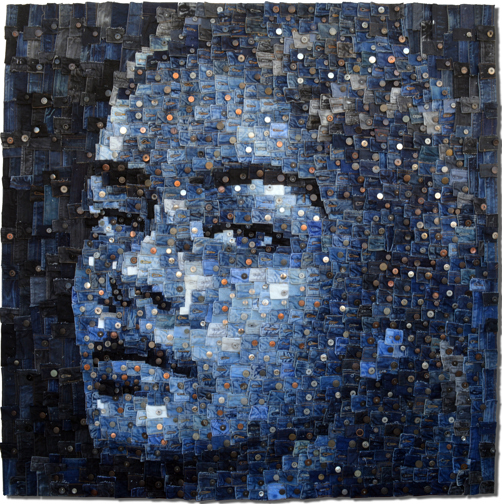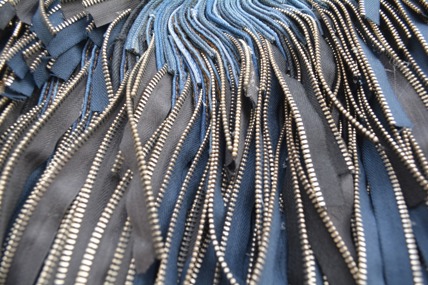The sustainability debate may rely heavily on technical innovations, but it shouldn’t ignore our responsibility as individuals. And art can be a great opportunity to see things through a different lens. It speaks to the consciousness of the senses and makes the issues related to sustainability poetically visible. Let’s hear more about sustainable art and how it can promote social awareness, from Deniz Sağdıç.

Ms. Sağdıç, could you introduce yourself to us? Who is Deniz Sağdıç? Could you tell us about your artwork?
I spent my childhood in the workshops of my artist relatives. My father is a master glassmaker, and in my elementary school days I was able to do most of my father's custom stained-glass orders. During summer, I would earn my own pocket money by converting old denim pants into purses and selling them in my aunt's tailor shop. So, even in those days I had already decided that I would spend my life creatively. I enrolled in the Department of Painting in Mersin University and graduated as the faculty's top student. I started my own studio, gave drawing lessons, and sold paintings, even if at low prices, way back in my university years. My teachers insisted that I stay at university as a lecturer because of my academic accomplishments, but I knew I was meant to be living in Istanbul, Turkey's art capital, if I wanted to become an artist. As soon as I graduated, I left everything behind and moved to Istanbul. After the early challenging years, I gradually began to be recognized for my work. I started with works on the social position of women, then moved beyond the limits of visual arts and continued with panels, interviews and workshop activities. I got accepted to the Painting Master's Program with a scholarship and graduated with a thesis on women. Now, I continue my life and work at my studio in Üsküdar.

What is your perspective on the relationship of sustainability and art? How do you define sustainable art?
Economic-based industries have inevitably had sustainability on their agenda for a long time. As we better understand global warming, sustainability has become a vision of showing each individual that they can no longer escape from their duties and responsibilities to protect nature. We are all consumers; but when we focus on the concept of “consuming”, just as energy is neither created or destroyed, we can see that we do not actually "consume" anything. Everything we throw away or leave behind, believing they had completed their purpose, continues to exist, even if in some other form, often harming nature and the environment. So, if we can somehow re-incorporate these never-disappearing forms that merely shape-shift, we can break this negative cycle. I aim to bring this form back to life through art. This also contributes to the sustainability of art, providing a platform and materials for the creation of it. Yet its greatest contribution in sustainability lies in its influence on the relationship between art and human. It is becoming increasingly difficult for non-professional people to understand and make sense of visual arts due to the materials, subjects, techniques or methods used. Thus, we are embarking in the opposite direction of our “reaching a larger audience” goal. However, if we create artwork from a product or an object that an individual uses regularly in their daily life and knows well, it brings with it a feeling of closeness and sincerity towards art. The art then transforms into a language and interprets the concept we would like to present to the audience. I think it is very important to establish such a language for the sustainability of art.
You evaluate waste in your artwork. How do you view the relationship between circular economy and art?
In the early days when I started working with waste materials, institutions that are part of the economy weren't very willing to collaborate with me. Yet I wanted to show them what could be done through recycling and inspire them in their field. They did eventually start cooperating, but their cooperation was mostly for show and prestige. In a system based on numbers, they were perhaps justifiably far from seeing the outcomes. Over time, they observed that sustainability affected the numbers if nurtured with not only mere intentions, but with patience and attitude as well. From that moment, organizations developed and diversified their collaborative projects with the art field on this topic. I think art plays a key role in the corporate internalization of this issue. If I hadn't insisted on my “garbage-stirring crazy artist” attitude, I couldn't have contributed to the patience process that allowed institutions to see these outcomes.

How did you become acquainted with the concepts of recycling and garbage art? How has your view of art evolved in this direction? Do you call yourself an activist artist due to your work in this field?
As is well known in the field, “conceptual art” is art in which an ordinary object is presented as it is without any drastic changes. The object of this art type is named “Ready-Made” in almost every language. This kind of art form we're used to doing today became very popular at some point. In fact, most art professionals began to think of conceptual art as the one and only unconditional art form, rather than a technique, and that if we wanted to mention concept in art, it would only be possible with conceptual art. To me, all forms of art are the embodiment of the concept, and art is the concept itself. In order to criticize this approach, I began to demonstrate art with the classic art methods, such as painting and sculpting on items or objects. These objects were mostly everyday items discarded and left aside, having completed their functions. I ironically named this project “Ready-ReMade”. The project is currently on-going with the idea of recycling and upcycling.
I don't find it very appropriate for someone who has the opportunity to use such a language and media like art to position themselves as an activist in this sense. If you are an artist, you should be able to create the idea and effect you are aiming for with your art.
What does society see in the sustainable art approach? Do you think people are more aware?
Iznik ceramics is an important part of our traditional art, and it is famous for its secret layer, giving smoothness and gloss. The content used in this layer is very special and its formula is hidden in its artist, that's why it is a “secret” layer. Though the secrets may bring admiration, this may create a sense of inadequacy for the audience, making them believe that they can only be spectators, thus causing art to separate from humanity and life itself. However, a more direct relationship will emerge if an artwork is created by the things that people use every day and know very well. Thus, it will be easier to express and understand the concept we intend to present. Art will be one of the most effective methods when you want to raise awareness about sustainability, as it does in all other subjects. I have been able to observe growing awareness on this topic for years. I can say this easily, because I probably have observed more than most organizations in this field. I have seen the increase in the number of institutions and individuals contacting me in order to provide materials for my artworks over the years. Recently, I have been receiving calls and messages from dozens of people a week saying that I can use their materials in my works. In fact, most of the time, they tell me their ideas on what kind of artwork I could make with these materials. They tell me that I inspire them and share their pictures of what they do with recycling. We can certainly talk about a visible increase in awareness in this regard.

How do you see the future of sustainable art, given the current circumstances?
Sustainable art and the sustainability of art are intertwined concepts for me. My work with waste materials can be described as sustainable art in this sense. On the other hand, what I am trying to accomplish with these works, that is to exhibit them in unusual areas of art, is associated with the sustainability of art. For example, areas like museums and galleries are art-based, but art is not the main theme at events like fairs or festivals, store showcases or product shelves. In fact, for me, these two different concepts have the same structure and idea, connecting with people. I use materials to connect with people and attempt to tap into the environment as well. The mission of museums, galleries and other art institutions is to bring art together with all parts of society, but in practice, they remain limited to producing content for a certain audience called “art lovers.” I’m constantly trying to figure out ways to bring art to the majority of people who cannot access these institutions and reach art due to the complexity of today’s urban life, or because of economic and social reasons. In doing so, I'm not just exhibiting my works, I'm also trying to do some artwork with the people who, for whatever reason, are in the workshops I've been organizing. The pandemic period we are in has effectively reminded us of the importance of the world's fundamental resources once again. We will enter a process where art will inspire people and institutions in all other fields much more about sustainability. On the other hand, the fact that art institutions have to close their doors these days show that all art professionals need to focus more on the sustainability of art.
How would you rate Arçelik’s sustainability efforts as an artist operating in this field?
Arçelik is one of the companies that make sustainability a matter of economic and social responsibility. As I have observed, Arçelik is also the first company in Turkey to express sustainability through art collaborations. Arçelik really inspires society and many organizations in different industries in this regard. Arçelik has been doing for a long time what I’m trying to do in art. I think Arçelik's approach and projects are parallel to my purpose and struggle. I hope that Arçelik’s vision on sustainability will continue to grow in the future.

 EN
EN  TR
TR
Share